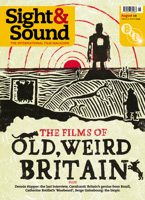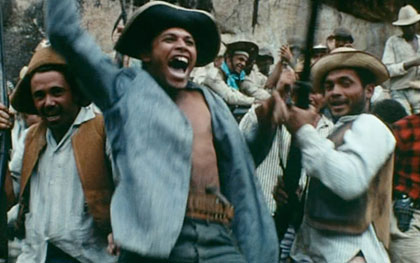Primary navigation


Michael Chanan on the extraordinary films of Glauber Rocha, shooting star of the Latin American new wave
Antônio das Mortes
Glauber Rocha; Brazil 1969; Mr Bongo/ Region 2; Certificate 18; 96 minutes; Aspect Ratio 1.33:1 (MFB 441)
Glauber Rocha’s Antônio das Mortes is surely one of the most astonishing films to come out of Brazil in the 1960s. A well-deserved Palme d’Or winner at Cannes in 1969, it starred Maurício do Valle as the eponymous ‘hero’ (whose name translates as Antonio of the Dead), a jagunço – hired killer – who first appeared in Rocha’s 1964 film Deus e o Diabo na Terra do Sol (literally, God and the Devil in the Land of the Sun but known in English as Black God, White Devil), where he is hired to dispose of Corisco, ‘the last cangaceiro’. The term cangaceiro refers to the social bandits, heroes of the oppressed, who operated in the sertão, the lawless northeast of Brazil, in the late 19th and early 20th centuries. Almost 30 years after the events of the earlier film, Antônio is called in again when a new cangaceiro emerges at the head of a small band of rebels – only to realise in the end that it was not the cangaceiro he should have been fighting but the landowners.
Rocha was the shooting star of Brazilian film, the enfant terrible of cinema novo, the Brazilian branch of the Latin American new wave of the day. Born in Bahia in northeast Brazil, he came to cinema as a teenager through film clubs, studied law for a couple of years, made some shorts, wrote prolifically, joined the group around Nelson Pereira dos Santos (whom he called the father of cinema novo) and directed his first feature, Barravento, in 1962. He would die young in 1981, after a stream of films that had a powerful influence on his contemporaries elsewhere in Latin America, especially Cuba, which gave him refuge for a while when he found himself persona non grata with the military rulers in Brazil.
Stylistically, Barravento had been a relatively straightforward piece of Latin American neorealism. In his subsequent work, including Antônio das Mortes, his first film in colour, Rocha developed a highly elliptical manner of narrative construction, full of emblematic characters performing stylised actions, in a peculiar amalgamation of history and legend, epic and lyric. This makes it very difficult to offer a simple and concise synopsis of the story, so I’m not going to try.

Rocha was not the first Brazilian film-maker to take up the subject of the cangaceiro. Indeed, the first Brazilian film to win the top prize at Cannes was Lima Barreto’s O Cangaceiro in 1953. The subject-matter of banditry and shootouts obviously lent itself to generations brought up on the Western, and here too there are echoes of the Hollywood genre but in a highly parodistic form. In a manifesto widely reprinted throughout Latin America and known as both The Aesthetics of Hunger and The Aesthetics of Violence, Rocha protested that people for whom hunger is a normal condition are suffering violence – the violence of the social system that makes them go hungry. We know, he said, this hunger will not be cured by moderate reforms, and its tumours aren’t hidden but only aggravated by the cloak of Technicolor. It was not only Hollywood he opposed but also the kind of Brazilian artist for whom misery becomes a form of exoticism that, as he put it, “vulgarises social problems”.
Rocha had a special fascination with the violence expressed in and through popular religious practices. For Rocha the mysticism of Brazilian popular religion, a syncretistic fusion of Catholicism and the motifs of African religion transplanted with the slave trade, became the expression of a permanent spirit of rebellion against unceasing oppression, a rejection and refusal of the condition in which the common people had been condemned to live for centuries. It also provided him with a model for the syncretism of his own film language, where the exuberant rush of images, the mix of mysticism and legend, cult and ritual, was married to a form of symbolism both political and surrealistic to achieve a visionary force. Antônio das Mortes is full of long takes, often static or else consisting of slow pans and travelling shots, cutting between wide shots and close-ups, with very little conventional continuity cutting within sequences. This made his films rather difficult for audiences outside Latin America to understand on first viewing. Indeed, I well remember when I first saw Antônio das Mortes as a young film critic in the early 1970s: I grasped practically nothing but was swept away by a compelling and mesmeric torrent of images and music. I came out of the screening knowing only that it had changed my notion of cinema forever.
There is something odd about this DVD edition, which carries no extras. The quality of the transfer is much better than some of Mr Bongo’s earlier releases, such as the 1968 Cuban film Memories of Underdevelopment by Tomás Gutiérrez Alea, which looked like a straight transfer of an uncleaned distribution print. This one, however, appears to have been made from one of those prints made for a dubbed French release married up to the original Portuguese soundtrack, since the opening titles appear in French, and several songs later in the film are subtitled in French, all with the English subtitles on top. Still, this is very much better than nothing, and demonstrates that Antônio das Mortes remains a film of extraordinary visual and allegorical power.